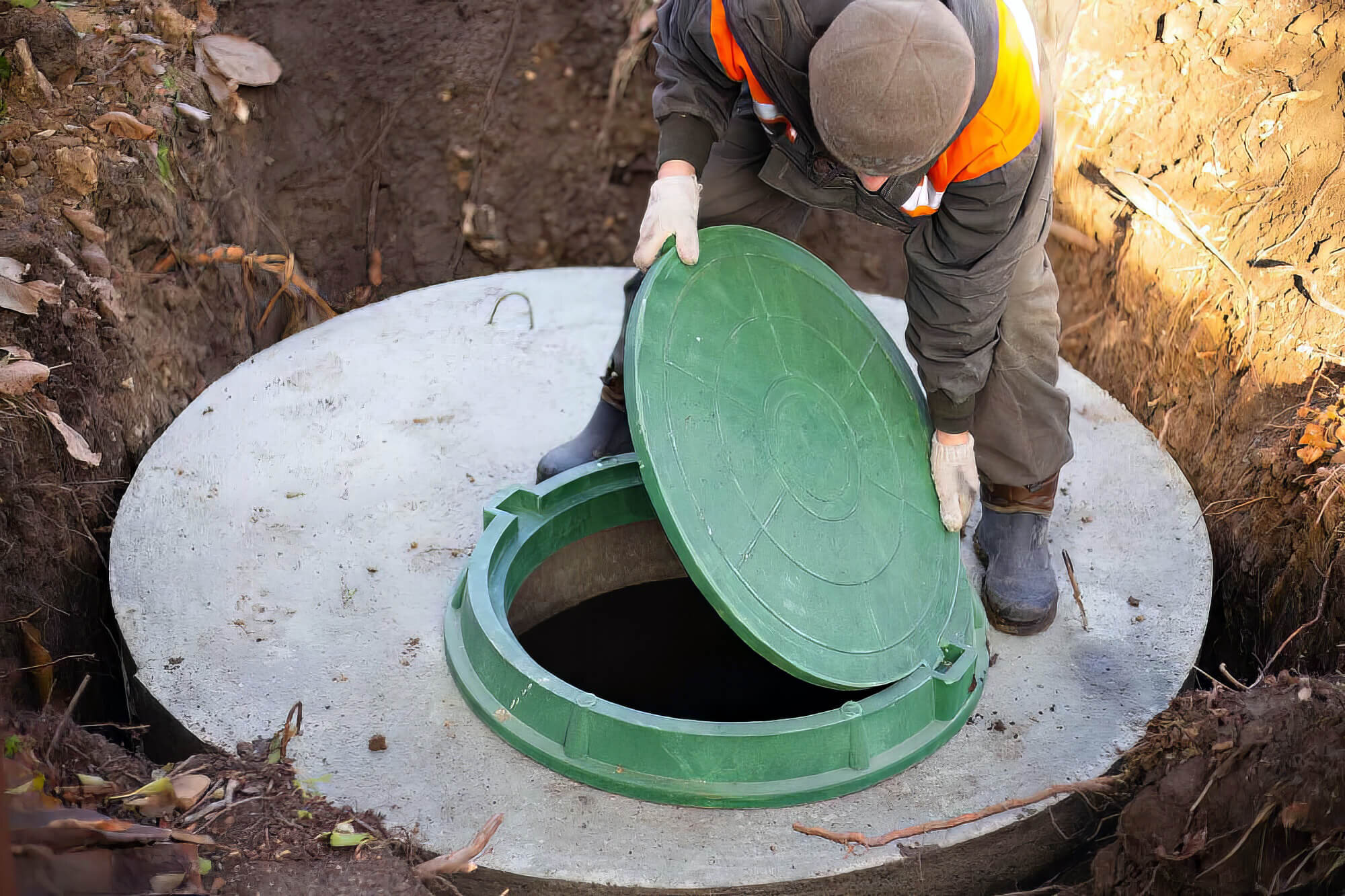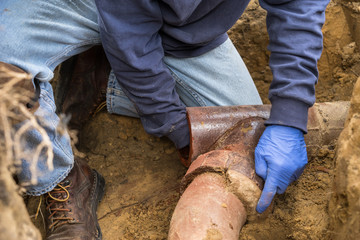A septic tank is a large, underground container that holds waste. As wastewater flows into the tank, solids separate and settle—with fats drifting to the top and sludge sinking to the bottom. The liquid wastewater, called effluent, exits the tank through a pipe and percolates into the soil to purify it.
Regular inspections and pumping keep your septic system working well. A full tank can produce foul odors in your home and yard. For more information, click the Septic Tank Armadale to proceed.

The inlet and outlet pipes are a critical part of the septic tank that direct wastewater into the tank and out to your absorption field. The pipes are usually 4-inch diameter PVC pipe with a watertight seal. Both the inlet and outlet tees must extend at least 1 inch into the water (above the floating scum layer) to prevent sewage or sludge from running straight out the tank outlet and rapidly clogging your absorption field and effluent piping.
In the septic tank, liquid waste separates into three layers. The first is oil and grease that floats above the water; this is often called the scum layer. The second layer is the wastewater that runs through the house plumbing. The bottom layer is solid waste that sinks and forms the sludge layer. Bacteria inside the septic tank breaks down these solids. The inlet and outlet tees ensure that the wastewater in the second chamber never flows into the absorption field and the sludge layer doesn’t enter the drainfield and cause premature system failure.
These tees also reduce the movement of gases from the septic tank toward the house. The septic tank is vented above the roof of the building through its plumbing vent system, which should be properly installed and maintained.
You can easily inspect the inlet and outlet tees from the outside of the septic tank; they are easy to see just above the scum layer in the tank. If the septic tank inlet baffle is missing, it doesn’t impact the tank’s function but it should be replaced to keep the inlet from being disturbed and causing a septic system backup.
The septic tank outlet baffle is required by the Texas Commission on Environmental Quality and must be present to protect the drainfield from sludge that could clog the drainage system. This baffle is a 2 or 3 inch wide section of the outlet pipe that extends at least 4 inches deeper in the water than the bottom of the inlet tee. This prevents the scum layer in the tank from being blown directly into the tank’s outlet pipe and causing drainfield clogs and premature system failure.
Essentially, the tank is a watertight box that’s designed to hold household waste until microorganisms decompose it. Solid waste sinks to the bottom forming sludge, oil and grease float to the top as scum, while liquid wastewater (effluent) exits the tank through a T-shaped outlet. Compartments in the tank prevent sludge and scum from passing through the outlet into the drain field.
Bacteria in the septic tank create gases as they digest the wastewater contaminants, including hydrogen sulfide, which has the smell of rotten eggs. To prevent a buildup of pressure that might stop or reverse the flow of wastewater, these gases are vented through a vent pipe in the tank’s lid.
A septic system must be properly sized to ensure that it will treat the amount of wastewater generated by a home. A qualified septic inspector will calculate the capacity of a septic system by examining the size of the septic tank, number of toilets and bathrooms, and household waste usage.
Regular inspections and pumping of a septic system reduces the risk of an overflow. A septic tank should be pumped at least once every three to five years. A septic tank that’s overfilled can cause the wastewater to leak out of the tank and into the drain field, where it can damage the soil and grass above it.
The septic system also includes a drainage field, which contains a network of perforated pipes in gravel-lined trenches that extend underground. The wastewater from the septic tank flows through these pipes into the absorption field, where it’s further treated by filtration and absorption into the ground.
It’s important to protect your septic system by not building structures, landscaping or parking on or near it. Doing so could compact the soil and block the flow of wastewater. You should also avoid using solvents and other chemicals that can kill the bacteria that process the waste in the septic tank or leach fields.
Finally, you should map out your septic tank and other system components so that you know where they are located in case you need to work on them. This will prevent you from accidentally destroying or damaging them during yard work or construction projects. It’s also a good idea to mark these areas with permanent stakes so that you can locate them when doing maintenance on the yard or home.
Once the bacteria inside the tank have broken down solid waste and sludge to liquid, wastewater exits into a drain field (also called an absorption field or leach field). The wastewater seeps through underground pipes in a gravel-covered area of soil to filter further before being absorbed by the grass above. The drain field protects your home from foul odors, slow-draining sinks and toilets, plumbing backups, and other problems caused by untreated wastewater.
As septic tanks age, solid waste sinks to the bottom of the tank and forms sludge, while liquids float to the top and are broken down by bacteria. Flowing through the outlet pipe, this mixture of liquid and solid waste (called effluent) flows out to the drain field via a series of perforated underground pipes. At the drain field, the effluent is further filtered through rocks, dirt and sand before it is naturally absorbed into the ground.
A septic system’s drain field can last up to 50 years with proper care, but it’s not something that most homeowners think about until it isn’t working properly. Like the septic tank itself, the drain field is susceptible to many of the same issues as other parts of your home:
The drain field can be overloaded if too much wastewater is flushed in a short period. This can cause the sludge layer to overflow into the absorption field, blocking holes in the pipe and depriving bacteria of oxygen needed for break down.
Tree and plant roots can also infiltrate the pipes and clog them. Items that shouldn’t be flushed can clog them too, as can a dripping faucet or running toilet. Finally, heavy equipment parked on or built over the drain field can compact the soil and block the flow of wastewater.
You can help prevent drain field problems by keeping grass, shrubs and other vegetation out of the area. It’s also a good idea to use only septic-safe toilet paper, and to check whether or not products you plan to flush are septic safe before sending them down the drain. And don’t pour grease or oils down your drains, as they will contaminate the septic tank and your drain field.
The wastewater in a septic tank contains many contaminants including bacteria, chemicals and viruses. When the liquid waste (effluent) leaves the septic tank it flows to a soil absorption area, also known as the drain field or leach field. The soil absorbs the liquid and helps to purify it. If the system is not properly maintained, this contaminated wastewater seeps into groundwater.
Most septic tanks are made of concrete or fiberglass and are rectangular in shape. Metal tanks are seldom used today. Fiberglass and composite plastic tanks offer a superior, almost water-tight seal. They may cost a little more than a concrete tank but can last much longer because they are less prone to corrosion. Concrete tanks can be reinforced with steel for extra strength. Regardless of the type of tank, it should be installed on a site that can handle the weight of the tank and the volume of the wastes that it will hold. Rocks in the soil can damage or crack the tank.
The inlet and outlet pipes should be constructed of acid-resistant Schedule 40 PVC, cast-iron or other approved pipe. These pipes should be protected by a baffle or sanitary tees that are a minimum of 4-inch in diameter. These protect the inlet and outlet from sludge buildup, and 6-inch diameter inspection pipes should be located above these baffles or tees for checking the solids level and clogs.
Septic tanks are generally sized to retain two days of sewage flow per day and house size; the size is determined by current regulations. The tank must be large enough to allow for adequate settling of solids and sufficient time for the bacteria in the wastewater to complete the treatment process. The septic tank must be inspected at least once a year and pumped every three to five years, depending on the home usage.
As the septic tank discharges, a layer of sludge forms on the bottom and a layer of scum floats on top. The clarified wastewater in the middle, called effluent, flows through the outlet into the soil absorption area. Depending on the type of septic system, the soil absorption area is a series of trenches and gravel covered with soil in which microbes treat the wastewater. Other types of systems include mound systems, seepage pits and cesspools.


